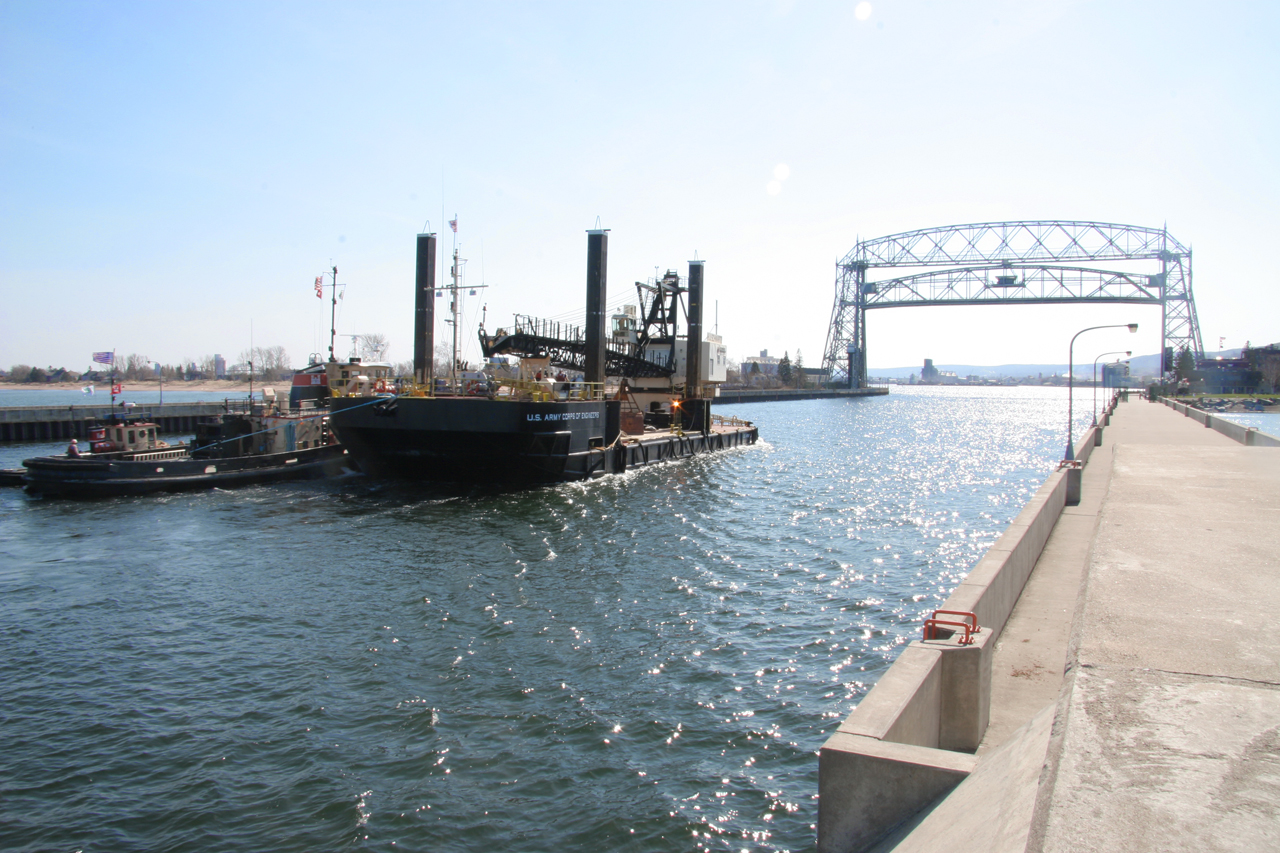Freight transportation (e.g., maritime, aviation, rail, and other surface transportation shipping) planning helps align land use plans with the movement of goods through and within local municipalities and regions to support the economic vitality of industries/businesses and reduce the potential for negative impacts (e.g., pollution, congestion, injuries to pedestrians) associated with the movement of freight.
Why is this important to your community?
Freight transportation is crucial to our way of life, local jobs and the economy. The delivery of goods and services to business, hospitals, and individual residences relies on numerous freight transportation systems and corridors throughout the country. This includes maritime, aviation, rail, and other surface transportation shipping. According to the Federal Highway Administration (FHWA), national freight volumes are expected to grow by more than 60% over the next 25 years. Freight transportation can have a significant positive impact on the economy of a region. However, communities without a clear strategy or plan for how to accommodate freight transportation may experience a number of negative impacts related to community health, air quality, and safety. As these activities increase across the nation and throughout our region, agencies including MPOs and COGs, are tasked with the responsibility of creating land use plans that provide adequate space for transportation facilities while reducing potential conflicts with adjacent land uses. Planning for freight transportation is beneficial to transportation companies, local municipalities, and residents alike. Benefits include greater efficiency, reduced congestion on major highways and streets, and improved in air quality. The Moving Ahead for Progress in the 21st Century Act (MAP-21), enacted in 2012, made a number of changes to improve the condition and performance of the national freight network and support investment in freight-related surface transportation projects. Specifically, it encourages each state to develop a comprehensive State Freight Plan and establish a State Freight Advisory Committee.
Skip directly to
How Does It Work?
Resources
Using the Tool
Partners
Where Has It Worked?
Where is it appropriate to use?
What priorities does it address?
How does it work?
Freight transportation planning is a local and a regional issue. Therefore, planning for freight transportation must involve a number of stakeholders from small businesses and freight companies to local governments and regional entities. Most of our country’s freight transportation systems are decentralized and disjointed. Planes, trains, and ships typically handle long-range shipping while trucks, vans, and other surface transportation provide door-to-door delivery of services and goods. Regional entities such as MPOs and COGs are well-suited to tackle the “big picture” issue of freight transportation and its effects. MPOs and COGs can help communities tackle these issues in a variety of ways. Services could include integrating freight planning into existing land use planning (e.g., scenario planning, long-range plans, etc.), providing technical assistance, creating a Freight Advisory Committee, or developing a guide to help local communities understand freight transportation system logistics (e.g., necessary facilities, programs, and the management of deliveries to local businesses in a variety of zoning districts). The planning process should include an analysis of existing conditions and the identification of gaps and potential land use conflicts. To ensure that recommendations include strategies that balance the needs of local communities and freight companies, the planning process should include numerous public engagement opportunities. Final recommendations should include actionable strategies (e.g., zoning changes, port improvements, designated freight corridors, development of centralized transportation hubs, etc.) at both the local and regional level.
Ready to get started?
Using the Tool
- Assemble a Freight Advisory Committee that will work with the MPO or COG throughout land use planning. The Committee should include representatives from transportation agencies, private freight companies, airports, businesses, residents, and other interested stakeholders.
- Provide support to communities where possible. MPOs and COGs can provide a number of services for local communities and the region. These services could include:
- Integrate freight transportation planning into local land use planning efforts and MPO plans
- Identify key freight transportation systems and corridors throughout the region. This could include maritime, aviation, rail, and other surface transportation shipping routes.
- Analyze existing conditions (e.g., air quality ratings, safety, zoning, etc.) and identify any gaps between existing freight capabilities and future demand. This analysis should also include any existing land use conflicts (e.g., residential land uses adjacent to transportation facilities, clusters of in-town businesses that are frequent shippers/receivers using large trucks, etc.).
- Host a number of land use planning public meeting meetings to gather input on issues and opportunities from residents and other stakeholders from the region and develop a set of goals and a vision. Utilize this data and input to inform recommendations for the region’s freight transportation system(s).
- Recommendations should include actionable strategies for local communities and the region as a whole. This could include changes to zoning, additional planning processes focused on specific transportation hubs, sites or communities, freight-centered policies or programs, or strategies to improve safety.
- Address land use and freight conflicts (existing and potential)
- Work with local municipalities who control land use and zoning to mitigate potential land use conflicts while taking into account the impact local decisions can have on the larger region-wide or national freight system.
- Hold public meetings to determine community concerns and establish goals. Consider using scenario planning tools to demonstrate the impact of various land and transportation uses.
- Ensure that plans and policies for freight transportation take into account community goals in an effort to reduce conflicts with local residents and businesses. For example, consider delivery schedules, parking/street width issues, noise ordinances, etc. as potential tools for community-level freight management.
- Develop a profile and performance measures for freight transportation
- Use existing data about transportation patterns and systems to create a freight transportation profile. This process could be purely data-driven or could include community and stakeholder engagement.
- Utilize this profile and performance measures (e.g., air quality, percent of on-time shipments, number of traffic incidents, etc.) to help make informed decisions about existing freight system capacity and future demand and need.
- Address impact on vulnerable communities
- Examine existing conditions and areas around planned transportation improvements – what communities are directly impacted by freight movement? Have these communities been exposed to environmental health hazards?
- Conduct public outreach to communities impacted by existing or proposed freight movement. Communities with predominately low income or minority residents are often disproportionately impacted by the negative effects of freight transportation.
- Work with the community and stakeholders to develop a strategies to mitigate the negative impact of freight movements (e.g., minimizing noise, light and air pollution)
- Integrate freight transportation planning into local land use planning efforts and MPO plans
- Work with partners (private freight companies, airports, businesses, transportation agencies, and others) following any planning process to determine what short-term actions can be taken to meet agreed upon goals. For example, if freight truck and vans are currently utilizing a key commercial or pedestrian corridor, work with local officials and transportation agencies to reroute truck traffic.
Partners
- Airports
- Businesses / Business Associations
- Economic Development Organizations
Where has it worked?
Duluth-Superior Metropolitan Interstate Council (MIC) - Duluth, MN – Superior, WI
About the Program
The Duluth-Superior region contains key corridors, including highways, rail lines, and a port, for both local and international freight movement. In recognition of the important role freight transportation plays in the region’s economy and the impact it has on communities, The Duluth-Superior Metropolitan Interstate Council (MIC), made freight movement a critical component of its long-range transportation plan, Direction 2035. The plan includes a “transportation asset management” strategy that provides a profile of each freight movement system (air, rail, truck, maritime, and pipeline) and an assessment of each system’s performance. Performance is measured based on accessibility and mobility; maintenance and operation; and safety and security. In addition to these measures, the plan offers a number of recommendations to improve performance measures over time.
Why it works
MIC recognized that planning for transportation involves the movement of people and freight. The movement of freight, just like the movement of people, can have a significant impact on land use patterns, the regional economy, and individual communities. In an effort to continue addressing freight transportation concerns, MIC created two advisory committees – the Transportation Advisory Committee (TAC) and the Harbor Technical Advisory Committee (HTAC). TAC is comprised of stakeholders and representatives from transportation agencies and local municipalities. HTAC works closely on issues impacting the Duluth-Superior Harbor and is comprised of a larger group of representatives from local municipalities, freight companies, environmental groups, and others. Both groups were formed as working groups to address challenges and advise MIC in freight transportation related issues.
Atlanta Regional Council (ARC) Freight Planning Program - Atlanta, GA
About the Program
The Atlanta region is a major freight and goods movement and distribution hub within the United States, as well as the key economic engine in he state of Georgia. In 2005, nearly 1 billion tons of freight traveled on the region’s transportation system, and the amount is expected to increase by 78 percent to nearly 1.7 billion tons by 2030. To respond to these trends, ARC has a proactive freight planning program to develop a framework for facilitating and enhancing freight mobility and goods movement in the region, improving the region’s economic competitiveness, and minimizing environmental and community impacts. ARC completed a Freight Mobility Plan in 2008, which relied heavily on data collection to identify clear policies to implement programming and improvements to accommodate increasing freight, goods, and services movements in the region.
Why it works
The impetus for the Atlanta Regional Freight Mobility Plan began in 2005, through collaboration with GDOT, and was driven by the Atlanta Regional Freight Task Force. The plan was the first ever done for the Atlanta region so therefore needed significant data collection and community and stakeholder involvement to develop strategies that would identify issues and opportunities and result in mutually beneficial outcomes. The input of private sector freight stakeholders was crucial to establishing goals and identifying issues and needs.
One of the most significant problems identified by logistics stakeholders was the lack of a regional truck route system, which made traversing the city by any means other than congested freeways very difficult for trucks. This issue and need has already been answered by the completion of the Atlanta Strategic Truck Route Master Plan (ASTRoMAP) in 2010. The plan recommends more streamlined truck movement across jurisdictional boundaries and where other barriers exist. This quick implementation reflects the level of commitment of the ARC in moving forward and acting upon its policy recommendations for freight planning.
- Businesses / Business Associations




